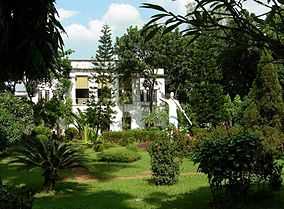Bhawal National Park
| Bhawal National Park | |
|---|---|
|
IUCN category V (protected landscape/seascape) | |
 | |
 | |
| Location | Gazipur, Dhaka Division of Bangladesh |
| Coordinates | 24°5′44.98″N 90°24′14.4″E / 24.0958278°N 90.404000°ECoordinates: 24°5′44.98″N 90°24′14.4″E / 24.0958278°N 90.404000°E |
| Area | 5022 hectares |
| Established | 1982 |
Bhawal National Park was established and maintained as a National Park in 1974; it was officially declared in 1982 under the Wildlife Act of 1974. It is located in Gazipur, Dhaka Division of Bangladesh, approximately 40 km north of Dhaka city, only 20 km drive from Gazipur and 20 km from Kapasia. The core area of the park covers 940 hectares but extends to 5,022 ha of surrounding forest. Its purpose is to protect important habitats as well as to provide opportunities for recreation. It has been kept under IUCN Management Category V, as a protected landscape. The most common flora is the unique coppice sal forest. The area was noted for peacocks, tiger, leopard, black panther, elephant, clouded leopard and sambar deer. However much of the wildlife had disappeared and only a few species remain. Also, most of the forest has been denuded and is now occupied by forestry companies or displaced people.[1][2]
Most of this area was covered by forests fifty years ago and the dominant species was Sal (Shorea robusta). Illegal deforestation has left only 600 km² of the forest and new trees and woodlands have been planted.[3]
The park has 220 plant species, including 43 different tree species, 19 shrubs, 3 palms, 27 grasses, 24 vines, and 104 herbs. The wildlife in the park includes 13 mammals, 9 reptiles, 5 birds and 5 amphibians. In addition the Forest Department has recently introduced peacocks, deers, pythons, and cat fish.[4]
See also
References
- ↑ "Wildlife Biodiversity in Bhawal National Park: Management Techniques and Drawbacks of Wildlife Managemetn and Nature Conservation". bangladesh.com. 2005. Retrieved 2011-09-30.
- ↑ "Wildlife Biodiversity in Bhawal National Park". School of Environmental Science and Management, Independent School, Bangladesh. Retrieved 2007-08-18.
- ↑ "Madhupur Tract". Asiatic Society of Bangladesh. Archived from the original on 9 August 2007. Retrieved 2007-08-18.
- ↑ "Eco tourism in Bangladesh". Bangladesh Forest Department. Retrieved 2007-08-18.
External links
- (PDF) Wildlife Biodiversity in Bhawal National Park
- Reading tools - Indexing Metadata - Wildlife Biodiversity in Bhawal National Park
- Nishorgo Biodiversity Program
- Protected Areas in Bangladesh